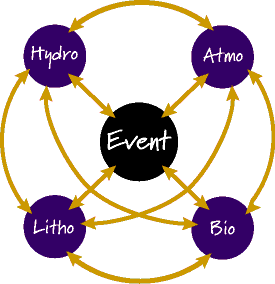Science 595GB: Geology in Education for Science Teachers - Syllabus
THEME: EARTH SYSTEM SCIENCE
(2 Units) - 2010 Syllabus
 Dr. Gerry Simila. gsimila@csun.edu
Dr. Gerry Simila. gsimila@csun.edu
Dr. Norm Herr norm.herr@csun.edu
Website
GS: Office: 1226 Live Oak Hall Phone: 677-3543
NH: Office: 2103 Education Bldg. Phone: 677-2505
COURSE DESCRIPTION: Earth System Science
In the phrase "Earth system science (ESS)," the key term is "system." A system is a collection of interdependent parts enclosed within a defined boundary. Within the boundary of the earth is a collection of four interdependent parts called "spheres." Earth's spheres include: the lithosphere, which contains all of the cold, hard, solid rock of the planet's crust (surface), the hot semi-solid rock that lies underneath the crust, the hot liquid rock near the center of the planet, and the solid iron core (center) of the planet; the hydrosphere, which contains all of the planet's solid, liquid, and gaseous water; the biosphere, which contains all of the planet's living organisms; and the atmosphere, which contains all of the planet's air.
Events can occur naturally, such as an earthquake or a hurricane, or they can be caused by humans, such as an oil spill or air pollution. An event can cause changes to occur in one or more of the spheres, and/or an event can be the effect of changes in one or more of Earth's four spheres. This two-way cause and effect relationship between an event and a sphere is called an interaction. Interactions also occur among the spheres; for example, a change in the atmosphere can cause a change in the hydrosphere, and vice versa.
COURSE OBJECTIVES: Our objectives are to investigate the Earth's systems and “events” that occur and the associated effects. Earth system science is conducted by examining each event-to-sphere, sphere-to-event, and sphere-to-sphere interaction. This approach is referred to as an "Earth system science analysis" or an "ESS analysis." We will conduct the ESS analysis for several events: Yellowstone fires, Mt Pinatubo volcanic eruption, El Nino, etc. We will use the strategy of Problem-Based Learning (PBL) which is an instructional methodology that uses real-world contexts for in-depth investigations of a subject matter. Finally, we will discuss the applications of ESS for your own classroom and students.
COURSE REQUIREMENTS
Homework assignments= 60% and Final Project = 40%
Grading (plus/minus) Scale: A = 90+%, B = 80-89%, C = 70-79%, D = 50-69%, F = 0-49%.
COURSE CALENDAR:
Sessions at CSUN
June 22, June 29, July 6, July 13; 4:00 PM - 7:00 PM; ED 2121B
WEEK 1 (6/20-24)
Introduction, Logistics (G)
Earth System Science (ESS) and Analysis (G)
Problem Based Learning (PBL) Model/ Inquiry Strategies (N)
ESS Analysis of the Yellowstone Fires (G)
Student Wiki; Elluminate, etc (N)WEEK 2 (6/27-7/1)
Earth System Science (ESS) and Analysis
Problem Based Learning (PBL) Model/ Inquiry Strategies
ESS Investigations-Rubrics
ESS Analysis of the Yellowstone Fires
Wikis; Elluminate, etcWEEK 3 (7/5-7/8)
Earth System Science (ESS) and Analysis
Mt. Pinatubo
WEEK 4 (7/11-7/15)
Earth System Science (ESS) and Analysis
California Climate: Pacific Ocean Connection (see also El Nino)WEEK 5 (7/18-7/22)
Earth System Science (ESS) and Analysis
Choose ESS ModuleWEEK 6 (7/25-7/29)
Earth System Science (ESS) and Analysis
Classroom Applications
Team: Final Project - Construct your own
Potential Modules
- Gulf Oil Spill
Energy for Me
Thermal Islands
NOTE: "The above schedule and procedures are subject to change in event of extenuating circumstances". Please see catalog and schedule of classes for academic and administrative policies.
